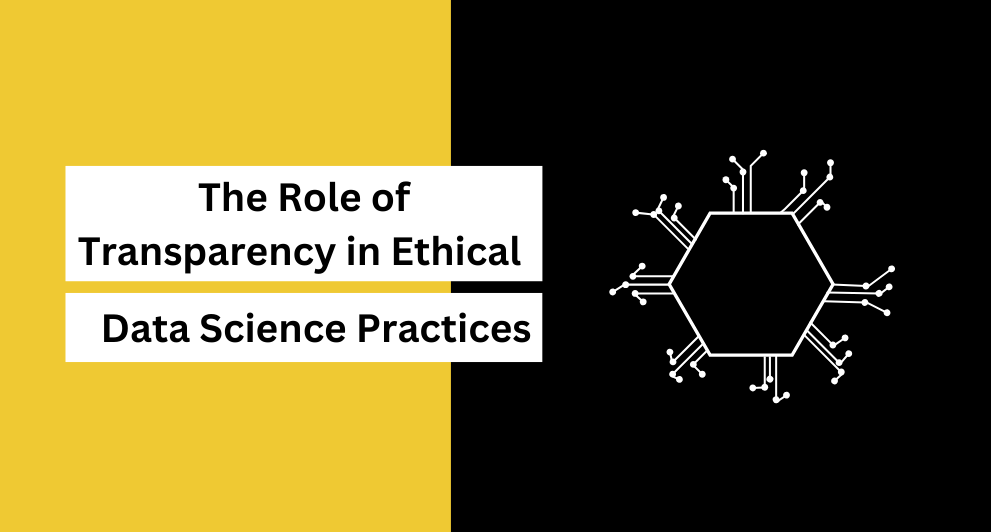In the world of tech, data science become a powerful tool for businesses, governments, and organizations to extract insights and make informed decisions. From personalized marketing campaigns to predictive healthcare models, the impact of data science is undeniable. However, with great power comes great responsibility. One of the most critical aspects of ethical data science practices is transparency. In this article, we will explore the role of transparency in fostering trust, ensuring fairness, and promoting accountability in data science.
Why Transparency Matters in Data Science
Transparency is the cornerstone of ethical practices in data science. It involves being open about how data is collected, processed, analyzed, and interpreted. This openness is essential for several reasons:
- Building Trust with Stakeholders
Data science often involves using personal or sensitive data, such as financial records, healthcare information, or behavioral patterns. When organizations are transparent about how they handle data, they build trust with their stakeholders—customers, employees, and the general public. Trust is a valuable asset that can improve customer loyalty, enhance brand reputation, and foster long-term relationships. - Ensuring Accountability
Transparency promotes accountability by making it clear who is responsible for decisions made using data science models. It helps identify errors, biases, or unethical practices early in the process. When organizations disclose the methodologies, algorithms, and assumptions behind their models, they allow others to scrutinize their work, leading to more robust and reliable results. - Promoting Fairness and Reducing Bias
Data science models are only as good as the data they are trained on. If the data is biased or incomplete, the results can perpetuate or even amplify inequalities. Transparency helps identify and mitigate biases in data collection and model development, ensuring that outcomes are fair and equitable for all groups, especially marginalized populations. - Compliance with Regulations
With data privacy regulations such as the General Data Protection Regulation (GDPR) and the California Consumer Privacy Act (CCPA), organizations are required to provide transparency in how they collect, store, and use personal data. Compliance with these laws not only avoids legal consequences but also aligns with ethical data practices.
Key Elements of Transparency in Data Science
Achieving transparency in data science involves several critical elements, each contributing to the ethical integrity of data-driven projects:
1. Data Collection Transparency
Organizations must be transparent about where and how they collect data. This includes informing individuals when their data is being gathered, explaining the purpose of the data collection, and obtaining explicit consent where necessary. Clear and accessible privacy policies are crucial in this regard, as they outline the scope of data use and the individuals’ rights regarding their information.
Example: A company that collects user data for targeted advertising must inform users of the types of data collected (e.g., browsing habits, location) and how it will be used (e.g., to serve personalized ads). Users should have the option to opt in or out of data collection.
2. Algorithmic Transparency
Algorithms are at the heart of data science models, but they can be complex and difficult for non-experts to understand. Algorithmic transparency involves explaining how algorithms work, the data they use, and the decisions they make. This transparency helps ensure that the models are not producing biased or unfair outcomes.
Example: In hiring algorithms, transparency would mean explaining the criteria used to evaluate candidates and ensuring that the algorithm does not disproportionately favor or disfavor certain groups based on gender, race, or age.
3. Model Interpretability and Explainability
Data science models, particularly those using machine learning, can be “black boxes” where it is difficult to understand how decisions are made. Interpretability and explainability are critical aspects of transparency, as they allow stakeholders to understand the reasoning behind a model’s predictions.
Explainability tools and techniques help data scientists interpret complex models, such as deep learning networks. These explanations make it possible to identify any potential biases or errors in the model, allowing for more responsible use of data.
Example: A bank using a machine learning model to determine creditworthiness should be able to explain why an individual was approved or denied a loan. The decision should be based on transparent and explainable factors, such as credit history and income, rather than opaque and potentially biased factors.
4. Data Governance and Documentation
Data governance refers to the policies and procedures in place to manage data assets effectively. It includes documenting the sources, ownership, quality, and lineage of data used in models. By maintaining detailed documentation of data processes, organizations ensure that they can answer questions about how data was used and why certain decisions were made.
Example: A healthcare provider that uses patient data to develop predictive models should have thorough documentation outlining where the data came from, how it was processed, and how the model was trained. This documentation is essential for both compliance and ethical accountability.
5. Clear Communication with Stakeholders
Transparency is not just about the technical aspects of data science; it’s also about communication. Organizations must communicate clearly and honestly with stakeholders about the data science processes they employ. This involves explaining technical concepts in a way that is accessible to non-experts, including the limitations and potential risks of the models.
Example: A retail company using data analytics to personalize customer experiences should communicate how it uses customer data for personalization and the benefits it brings to customers. This helps customers understand the value of sharing their data while also respecting their privacy.
Challenges in Achieving Transparency
While transparency is a fundamental ethical principle in data science, it is not without its challenges:
- Complexity of Algorithms and Models
Some data science models, particularly those using deep learning or neural networks, are highly complex. Explaining how these models work to non-experts can be difficult, leading to challenges in achieving true transparency. - Trade-offs Between Transparency and Intellectual Property
Companies may be hesitant to fully disclose their algorithms or data sources due to concerns about protecting intellectual property or competitive advantage. Finding a balance between transparency and proprietary knowledge is a delicate issue that many organizations face. - Privacy Concerns
Transparency must be balanced with privacy. While it is important to be transparent about data practices, organizations must also protect the privacy of individuals, particularly when dealing with sensitive data such as healthcare information or financial records. - Bias Detection and Mitigation
Identifying and mitigating biases in data and algorithms is challenging. Even with transparency, it can be difficult to ensure that all potential biases have been addressed. Ongoing monitoring and evaluation are necessary to minimize the risk of biased outcomes.
Best Practices for Ensuring Transparency in Data Science
To promote transparency in data science practices, organizations can adopt several best practices:
- Regular Audits and Reviews
Conducting regular audits of data practices, algorithms, and models helps ensure that transparency is maintained throughout the lifecycle of a data science project. Audits can identify potential biases, errors, or areas for improvement. - Involving Diverse Teams
Diverse teams bring different perspectives to the table, which can help identify potential ethical issues or biases that may go unnoticed in a homogeneous team. Involving individuals from different backgrounds in the development and evaluation of data science models promotes fairness and accountability. - Open Source Models and Tools
Where possible, organizations can use or contribute to open-source data science tools and models. Open-source tools promote transparency by allowing the community to scrutinize and improve algorithms, ensuring that they are fair and unbiased. - Clear and Accessible Documentation
Maintaining thorough documentation of data sources, algorithms, and decision-making processes ensures that all stakeholders can understand and evaluate the ethical implications of data science projects. Documentation should be written in plain language that is accessible to non-experts. - Engaging with Stakeholders
Engaging with stakeholders, including customers, employees, and regulators, is essential for maintaining transparency. Organizations should provide clear explanations of how data is used and offer opportunities for stakeholders to ask questions or raise concerns.




